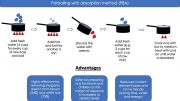
A recent nationwide study on public water systems discovered uneven arsenic levels in the U.S., even after adopting the latest regulatory standard.
Odds of exceeding maximum contaminant levels were significantly greater for water systems in the Southwest and serving Hispanic communities.
A new national study of public water systems found that arsenic levels were not uniform across the U.S., even after implementation of the latest national regulatory standard. In the first study to assess differences in public drinking water arsenic exposures by geographic subgroups, researchers at Columbia University Mailman School of Public Health confirmed there are inequalities in drinking water arsenic exposure across certain sociodemographic subgroups and over time. Community water systems reliant on groundwater, serving smaller populations located in the Southwest, and Hispanic communities were more likely to continue exceeding the national maximum containment level, raising environmental justice concerns. The findings are published online in Environmental Health Perspectives.
“This research has important implications for public health efforts aimed at reducing arsenic exposure levels, and for advancing environmental justice,” said Anne Nigra, PhD, postdoctoral research fellow in environmental health sciences, and first author. “Systematic studies of inequalities in public drinking water exposures have been lacking until now. These findings identify communities in immediate need of additional protective public health measures.”
‘Our objective was to identify subgroups whose public water arsenic concentrations remained above 10 μg/L after the new maximum arsenic contaminant levels were implemented and, therefore, at disproportionate risk of arsenic-related adverse health outcomes such as cardiovascular disease, related cancers, and adverse birth outcomes,” said Ana Navas-Acien, PhD, Professor of Environmental Health Sciences and senior author.
Arsenic is a highly toxic human carcinogen and water contaminant present in many aquifers in the United States. Earlier research by the Columbia research team showed that reducing the MCL from 50 to 10 μg/L prevented an estimated 200-900 cancer cases per year.
The researchers compared community water system arsenic concentrations during (2006-2008) versus after (2009-2011) the initial monitoring period for compliance with EPA’s 10 μg/L arsenic maximum contaminant level (MCL). They estimated three-year average arsenic concentrations for 36,406 local water systems and 2,740 counties and compared differences in means and quantiles of water arsenic between both three-year periods for U.S. regions and sociodemographic subgroups.
Analyses were based on data from two of the largest EPA databases of public water available. Using arsenic monitoring data from the Third Six Year Review period (2006-2011), the researchers studied approximately 13 million analytical records from 139,000 public water systems serving 290 million people annually. Included were data from 46 states, Washington D.C., the Navajo Nation, and American Indian tribes representing 95 percent of all public water systems and 92 percent of the total population served by public water systems nationally.
Regional Differences
For 2006-2008 to 2009-2011, the average community water system arsenic concentrations declined by 10 percent nationwide, by 11.4 percent for the Southwest, and by 37 percent for New England, respectively. Despite the decline in arsenic concentrations, public drinking water arsenic concentrations remained higher for several sociodemographic subgroups — Hispanic communities, the Southwestern U.S, the Pacific Northwest, and the Central Midwest., in particular. Likewise, communities with smaller populations and reliant on groundwater were more likely to have high arsenic levels.
The percent of community water systems with average concentrations arsenic above the 10 μg/L MCL was 2.3% in 2009-2011 vs. 3.2% in 2006-2008. Community water systems that were not compliant with the arsenic MCL were more likely in the Southwest (61 percent), served by groundwater (95 percent), serving smaller populations (an average of 1,102 persons), and serving Hispanic communities (38 percent).
Nigra and Navas-Acien say that estimating public drinking water arsenic exposure for sociodemographic and geographic subgroups is critical for evaluating whether inequalities in arsenic exposure and compliance with the maximum contaminant levels persist across the U.S, to inform future national- and state-level arsenic regulatory efforts, and to investigate whether inequalities in exposure by subgroup contribute to disparities in arsenic-related disease. “Our findings will help address environmental justice concerns and inform public health interventions and regulatory action needed to eliminate exposure inequalities.”
“We urge continued state and federal funding for infrastructure and technical assistance support for small public water systems in order to reduce inequalities and further protect numerous communities in the U.S. affected by elevated drinking water arsenic exposure,” said Nigra.
Reference: “Inequalities in Public Water Arsenic Concentrations in Counties and Community Water Systems across the United States, 2006–2011” by Anne E. Nigra, Qixuan Chen, Steven N. Chillrud, Lili Wang, David Harvey, Brian Mailloux, Pam Factor-Litvak and Ana Navas-Acien, 9 December 2020, Environmental Health Perspectives.
DOI: 10.1289/EHP7313









In that area grass and other forage is higher in arsenic or so the local farming community tells us. We order hay from upper East Coast of USA.
Can this Arsenic be chemically (or atomically) compared to the Arsenic used on farmers crops via “RoundUp” and also compared to the Arsenic used on farmers crops back before the farmers switched to DDT (because DDT was safer to humans). This is how it got to be so problematic in ground water, the years of run off from crop use and of course the wholesale dumping rather than proper disposal. In fact it might be easy to source potential chemical (or other) signature (structure) of arsenic given the certain U.S. companies still manufacture DDT and Arsenic to be sold and used on crops overseas. Oddly enough, we the oh-so-smart people in the USA, buy those same crops for shipment back to the USA, ignorant of the use of chemicals banned here in the USA.